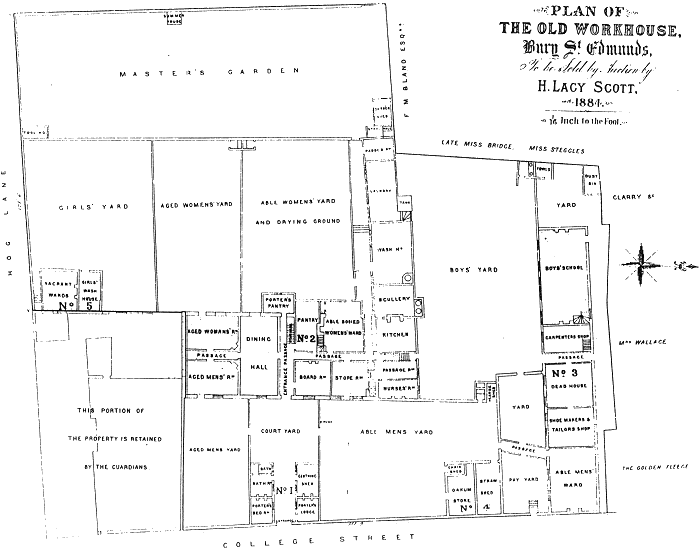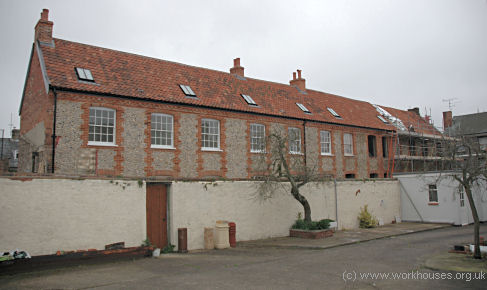Bury St Edmunds, Suffolk
Up to 1834
The earliest workhouse in Bury St Edmunds dates back to before 1621 and was located in a house in Whiting Street. In 1622, a house in Churchgate Street was adapted as a workhouse, then from about 1630 Moyses Hall was used a workhouse, a house of correction, and the town gaol. By the early 1700s, the town had two workhouses — one in Eastgate Street for the parish of St James, and one in Schoolhall Street for St Mary's.
In 1747, the parishes of St James and St Mary's were incorporated under a local Act of Parliament (21 Geo. 2, An Act for erecting Workhouses, for the better employing and maintaining the Poor within the Burgh of Bury Saint Edmunds; and for the better repairing and paving the Streets and Highways there.). The Incorporation was managed by "twelve persons chosen out of the honestest and discreetest inhabitants occupying tenements of 8l. yearly rent" together with twelve ex officio members from the Borough's aldermen, recorder, coroner, assistant justices and capital burgesses.
In 1748, the new Incorporation paid Thomas Woodroffe the sum of £420 for a house on College Street, formerly part of Jesus College, and converted it into a workhouse.
A parliamentary report of 1777 recorded that the Bury St Edmunds workhouse could accommodate 250 inmates.
After a visit to the Bury St Edmunds workhouse in 1805, the philanthropist and prison reformer James Neild was far from impressed at what he had found. The building was dirty and badly ventilated. There was no daily table of diet prescribed for the inmates. He also discovered that the twenty-eight children in the workhouse who were in a state of nearly total ignorance, although several of them had spent fourteen years of their lives there.
After 1834
Because of its Local Act status, Bury St Edmunds was exempted from most of the provisions of the 1834 Poor Law Amendment Act. In the 1840s, The College Street workhouse underwent alterations costing around £1,000. The architect for the enlargement work was William Mason who had undertaken a similar project for Hartismere Union, and also designed the Union workhouse at Ipswich.
A plan from 1884 shows the workhouse layout at that date:

Bury St Edmunds plan, 1884.
The north-east range of the workhouse contained the men's ward, workshops for shoe-making, tailoring and carpentry, the boys' school, and the mortuary.

College Street workhouse north-east range from the south-west, 2005.
© Peter Higginbotham.
The workhouse was closed in around 1880 after which time the Incorporation's indoor poor as well as vagrants were maintained at the nearby Thingoe Union workhouse on Mill Lane. Most of the College Street site was then sold by auction, except for a portion that was retained for use as a board-room, pay-room, vaccination station, and relieving officer's office and residence.
On 11th November 1907, Bury St Edmunds formally joined the Thingoe Union which was itself renamed the Bury St Edmunds Union.
Only the north-east range of the College Street building now survives. In 2005 it was converted into residential accommodation.
Children's Home
By 1924, the Bury St Edmunds union had established a children's home known as the Alexandra Home on Hospital Road, Bury St Edmunds. In that year, the home could house 28 children and the Superintendent was Miss Weeks. The property later became a council-run nursery and children's home known as Alexandra House.
Staff
Inmates
Records
Note: many repositories impose a closure period of up to 100 years for records identifying individuals. Before travelling a long distance, always check that the records you want to consult will be available.
- Suffolk Archives, 77 Raingate Street, Bury St Edmunds IP33 2AR. Holdings include: Incorporation minutes (1748-1841); Union minutes (1841-1930).
Bibliography
- Plumridge, P (1998) Riches and Rags: the history of a site in College Street, Bury St. Edmunds 1480-1997
Links
Unless otherwise indicated, this page () is copyright Peter Higginbotham. Contents may not be reproduced without permission.


